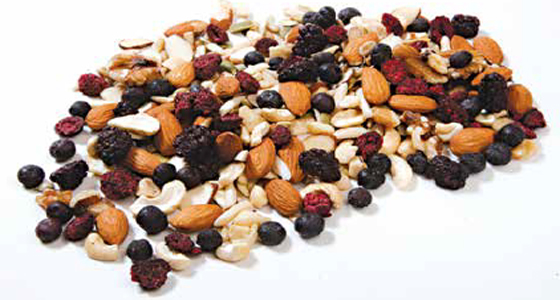The Morning Jump-Start
NUTRACEUTICALS

Referred to as the most important meal of the day, breakfast is often overlooked. What breakfast skippers don’t realize is that they are missing out on the reported benefits of eating a nutritious breakfast.
At the 2012 IFT Annual Meeting & Food Expo®, a panel discussion focused on the importance of eating breakfast. People who do not eat breakfast tend to weigh more and have other unhealthy habits such as consuming too many sugary drinks or high-calorie snacks compared to those who eat breakfast (IFT, 2012). The research showed that about 18% of Americans older than age 2 regularly skip breakfast, said Nancy Auestad, Vice President of Regulatory Affairs, Dairy Research Institute. They are missing out on key nutrients, she said, pointing to statistics that show breakfast-eaters get about 17% of their daily calories from breakfast as well as a significant portion of their daily recommended intake of several key nutrients such as vitamin D (58%), vitamin B-12 (42%), and vitamin A (41%).
Eating breakfast has also been shown to benefit weight management and mental performance throughout the day. In terms of weight, eating breakfast has been shown to help people avoid overeating and cravings for high-calorie foods (Society for Neuroscience, 2012). Magnetic resonance images (MRIs) of brains showed that when people skip breakfast, the pleasure-seeking part of the brain is activated by pictures of high-calorie food, according to a research study led by Tony Goldstone from the MRC Clinical Science Centre, Imperial College. The research, presented at the 2012 Annual Meeting of the Society for Neuroscience, also showed that skipping breakfast appeared to increase food consumption at lunch.
Maffeis et al. (2012) showed that attention and visual memory performance in the morning were reduced when children skipped breakfast. Cooper et al. (2011) reported that breakfast consumption produced higher self-reported energy and fullness, lower self-reported tiredness and hunger, and higher blood glucose concentrations in adolescents.
Here is a look at some breakfast components that can help consumers kick-start their days.
Protein
During the panel discussion about breakfast held at the 2012 IFT Annual Meeting & Food Expo, Heather Leidy, Assistant Professor in the Dept. of Nutrition and Exercise Physiology at the University of Missouri, presented research focusing on the role of protein in breakfast. The results showed that eating a healthy breakfast of any kind led to more satiety and less overeating throughout the day, but these benefits were especially prominent among the subjects who ate a high-protein breakfast. MRIs of brains showed that consuming a protein-rich breakfast reduced the brain signals controlling food desires, even many hours after breakfast.
Soy, whey, and egg proteins have been shown to provide satiety and benefits for muscle building/maintenance. Soy protein, in particular, can be found in many breakfast meat alternatives such as vegetarian sausages.
Whey protein contains high-quality protein and the highest concentration of branched-chain amino acids, making it ideal for both pre- and post-workout breakfast snacks and meals. Typical American breakfast foods such as toast, bars, waffles, pancakes, juice, and pastries are low in protein. Many popular breakfast cereals contain only 2–3 g of protein/serving (Gerdes, 2011). Adding a 1/2-cup (118 mL) serving of milk provides an additional 4 g of protein. A 1-cup (237 mL) serving of whey protein-fortified milk provides an additional 10–15 g of protein. “There are some products on the market that are promoting higher levels of protein in cereals and breakfast items,” said Loren Ward, Director, R&D, Glanbia Nutritionals, Twin Falls, Idaho (phone 208-735-4700, www.glanbianutritionals.com). “I believe we are still on the front end of this trend and that as consumers understand the value in spreading protein consumption across the three meals of the day, there will be an increase in breakfast items that contain protein.” Yogurt, for example, is a popular breakfast choice for consumers. “Manufacturers can increase the protein content of yogurt using OptiSol™ 1022, a functional milk protein concentrate that creates thicker yogurt viscosity while boosting protein,” explained Ward. Another example would be fortifying cereal and granola clusters with OptiSol 2000, a protein binder that can also reduce sugar by up to 50%.
Eggs provide some of the highest quality protein of any food, as well as being one of the few nondairy sources of vitamin D, according to the American Egg Board, Park Ridge, Ill. (phone 847-296-7043, www.aeb.org). Fallaize et al. (2012) showed that subjects experienced increased satiety, less hunger, and a lower desire to eat after a breakfast containing eggs relative to cereal- and croissant-based meals. In addition to the increased satiety, the egg breakfast was also accompanied by a significantly lower intake of energy relative to the cereal- and croissant-based breakfasts at a buffet lunch and dinner.
Fruits and Nuts
Blueberries and almonds are popular in cereals and breakfast bars due to consumers’ high familiarity with their flavor, appearance, and reported health benefits. “We continue to see an increased use of blueberry and blackberry in breakfast foods, including cereals, breakfast bars, yogurt, pancakes, muffins, and smoothie products,” observed Michael Sorenson, President and General Manager, Milne Fruit Products Inc., Prosser, Wash. (phone 509-786-2611, www.milnefruit.com). Milne offers the MicroDried ® product line of blueberry and blackberry whole pieces, fragmented pieces, and powders, making it convenient to add these popular fruits to breakfast foods. The fruits are whole fruits that retain nutrition and size (if whole pieces) very similar to fresh berries, just without the moisture.
Blueberries are included in breakfast foods for their nutrition, overall appeal, and ease of formulation. They are low in calories, virtually fat-free, and a source of fiber, vitamins, minerals, and antioxidants, according to information from the U.S. Highbush Blueberry Council, Folsom, Calif. (phone 916-983-0111, www.blueberry.org). Consumers know that blueberries have high antioxidant activity and reported health benefits in areas such as cognition, cardiovascular disease, and cancer. “Because blueberries are homey and familiar, they help make novel and innovative products less intimidating—they can actually give the product ‘curb appeal,’” according to the U.S. Highbush Blueberry Council.
--- PAGE BREAK ---
More than half (58%) of North Americans think of almonds first when they think of nuts in cereal, according to the Almond Board of California, Modesto, Calif. (phone 209-549-8262, www.almondboard.com). Almonds outscore other nuts on two key attributes consumers say they are looking for when choosing breakfast products: “is tasty and nutritious” and “fills me up until lunch.” When compared ounce for ounce, almonds are the tree nut highest in protein (6 g), fiber (3.5 g), calcium (75 mg), vitamin E (7.4 mg), riboflavin (0.3 mg), and niacin (1 mg).
In addition, almonds add heart health and satiety benefits to breakfast foods. A study published in 2012 by Richard Mattes, Distinguished Professor of Nutrition Science, Purdue University, supported consumers’ desire for nutrition with great flavor and satiety at breakfast (ABC, 2012). The results showed that including a low-glycemic index food (almonds) in a high-glycemic index breakfast can moderate the rise in blood sugar during the morning hours and that the effect may continue during, and for several hours after, the next meal of the day.
Whole Grains
Whole grains are rich sources of vitamins, minerals, dietary fiber, lignans, beta-glucan, inulin, phytochemicals, and phytosterols. Scientific evidence indicates that whole grains play an important role in lowering the risk of chronic diseases such as coronary heart disease, diabetes, and cancer and contributing to body weight management and gastrointestinal health (Jonnalagadda et al., 2011).
Brown rice is a whole grain that is an excellent source of manganese and a good source of selenium. Researchers at the Dept. of Food Science and Nutrition at the University of Minnesota showed that consuming white or brown rice provided a high level of satisfaction and fullness compared to consuming a glucose beverage (USA Rice, 2012).
A variety of innovative whole-grain and whole-wheat flours are making it easier for manufacturers to create nutritious and tasty whole-grain breakfast items. “Many choices are available when adding whole-wheat flour to breakfast products based on the taste, texture, and appearance manufacturers may be interested in,” explained Brook Carson, Director of R&D, ADM Milling, Overland Park, Kan. (phone 800-422-1688, www.adm.com/en-US/Milling). “A coarse granulation red wheat might be a good choice for a breakfast bread used for toast. This would provide a hearty flavor and texture for those consumers who really like and appreciate whole-grain products. A fine granulation white wheat may be good for a whole-grain blueberry muffin, ideal for those consumers who may want the healthfulness of whole grain but not want an impact on flavor and texture. A ‘made with whole grain’ tortilla would be a good way to add whole grains to a hearty, hot meal.”
ADM Milling offers whole-grain sorghum flour for whole-grain, multi-grain, and gluten-free breakfast items. “In addition to providing a gluten-free grain alternative, the whole-grain sorghum flour works wonderfully in extruded products,” said Carson. “It expands well and offers a nice, crisp texture perfect for cereals, snacks, and nutrition bars. Sorghum also would work well for adding whole grain to muffins, pancakes, or scones, either alone or along with whole-wheat flour.”
ConAgra Mills, Omaha, Neb. (phone 800-851-9618, www.conagramills.com), offers a selection of multi-use flours and whole grains, including Ultragrain ®, the 100% whole-wheat flour with the taste, texture, and appearance most like white flour, Sustagrain ® high-fiber barley, and a line of ConAgra Mills Ancient Grain flours. Ultragrain is made with specially selected white wheat that is milder, sweeter, and lighter in color than red whole wheat. It is milled using a method that retains all of the whole-grain nutrition while achieving the consistency of white flour. The company in 2012 introduced Ultragrain High Performance, offering advantages such as reduced added gluten requirements and greater mix tolerance.
Horizon Milling LLC, Minneapolis, Minn. (phone 800-742-4506, www.horizonmilling.com), offers WheatSelect ® white spring whole-wheat flour that combines 100% whole-wheat nutrition with premium baking performance and more of the sensory attributes consumers prefer. It is made from select wheat varieties that optimize key baking characteristics like volume, mixing, and processing tolerance. An advanced flour milling process results in fine-grind flour that preserves whole-grain nutrients while optimizing granulation size for excellent baking performance.
 Linda Milo Ohr, Contributing Editor, Denver, Colo.
Linda Milo Ohr, Contributing Editor, Denver, Colo.
[email protected]
References
ABC. 2012. Consumers and food professionals choose almonds to build a better breakfast. Press release, June 12. Almond Board of California, Modesto, Calif.
Cooper, S.B., Bandelow, S., and Nevill, M.E. 2011. Breakfast consumption and cognitive function in adolescent school children. Physiol. Behav. 103(5): 431-439.
Fallaize, R., Wilson, L., Gray, J., Morgan, L.M., and Griffin, B.A. 2012. Variation in the effects of three different breakfast meals on subjective satiety and subsequent intake of energy at lunch and evening meal. Eur. J. Nutr. First published online September 5, doi: 10.1007/s00394-012-0444-z.
Gerdes, S. 2011. Whey protein in breakfast foods. Marketing Monograph. U.S. Dairy Export Council, Arlington, Va.
IFT. 2012. Skipping breakfast can lead to unhealthy habits all day long. Press release, June 28. Institute of Food Technologists, Chicago, Ill.
Jonnalagadda, S.S., Harnack, L., Liu, R.H., McKeown, N., Seal, C., Liu, S., and Fahey, G.C. 2011. Putting the whole grain puzzle together: health benefits associated with whole grains—summary of American Society for Nutrition 2010 Satellite Symposium. J. Nutr. 141: 1011S-1022S.
Maffeis, C., Fornari, E., Surano, M.G., Comencini, E., Corradi, M., Tommasi, M., Fasan, I., and Cortese, S. 2012. Breakfast skipping in prepubertal obese children: hormonal, metabolic and cognitive consequences. Eur. J. Clin. Nutr. 66(3): 314-321.
Society for Neuroscience. 2012. This is your brain on food: studies reveal how diet affects brain functions. Press release, October 16. Society for Neuroscience, Washington, D.C.
USA Rice. 2012. Attention dieters: rice helps fill you up… not out! Press release, June 26. USA Rice Federation, Arlington, Va.


